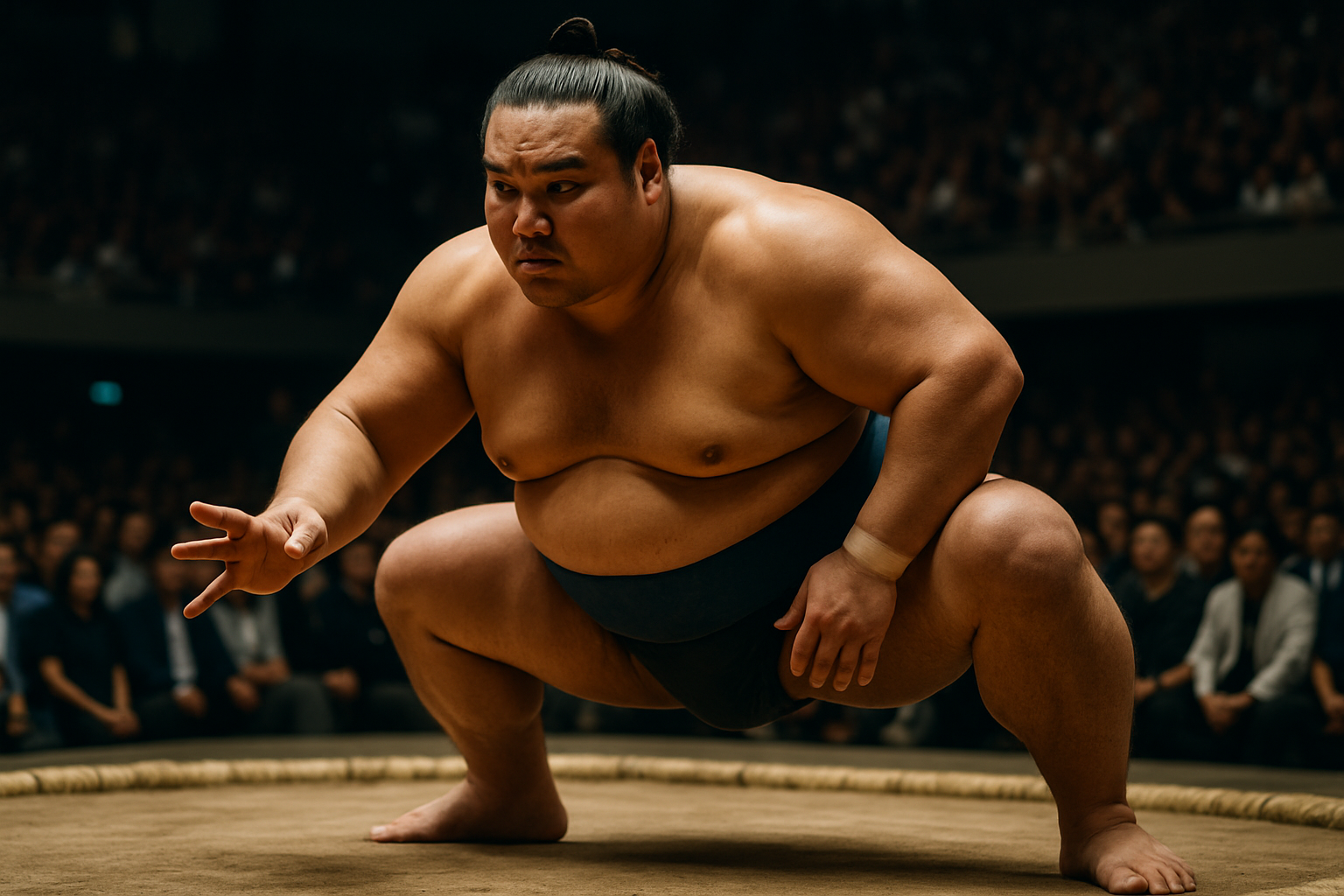Sumo's Renaissance: The Ancient Sport's Modern Resurgence
In the bustling heart of Tokyo, a thunderous clash echoes through a packed arena. Two massive athletes, their bodies honed to perfection, engage in a fierce battle of strength and strategy. This isn't just any sport—it's sumo, Japan's national treasure, experiencing an unprecedented revival. As global interest surges and new generations of athletes emerge, sumo is shedding its traditional image and embracing a dynamic future.

The basic rules of sumo have remained largely unchanged for centuries. Two wrestlers, or rikishi, face off in a circular ring called a dohyo. The objective is simple: force your opponent out of the ring or make any part of their body, other than the soles of their feet, touch the ground. Matches are often over in seconds, but the preparation and ritual surrounding each bout can last several minutes.
Despite its long history, sumo faced declining popularity in the late 20th century. Younger generations in Japan were drawn to more modern sports, and sumo struggled with scandals and a lack of domestic talent. However, the past decade has seen a remarkable turnaround, breathing new life into this ancient sport.
Global Appeal: Sumo’s International Fanbase
One of the most significant factors in sumo’s resurgence has been its growing international appeal. While sumo has always had a small but dedicated following outside Japan, recent years have seen a surge in global interest. This can be attributed to several factors, including increased media coverage, the rise of social media, and the success of non-Japanese wrestlers in the sport.
Streaming platforms and dedicated sumo channels have made it easier than ever for fans around the world to follow tournaments in real-time. Social media has played a crucial role in this global expansion, with highlight reels and behind-the-scenes content giving fans unprecedented access to the world of sumo. The rise of international stars in the sport has also contributed to its growing appeal.
Mongolian-born yokozuna (grand champions) like Hakuho and Kakuryu have dominated the sport for years, inspiring a new generation of international wrestlers. Wrestlers from countries such as Georgia, Bulgaria, and Brazil have found success in sumo, broadening its appeal and challenging the notion that it’s a sport exclusively for Japanese athletes.
This internationalization has not been without controversy. Some traditionalists worry about the dilution of sumo’s cultural significance, while others argue that the influx of foreign talent has revitalized the sport and pushed Japanese wrestlers to new heights of performance.
The Science of Sumo: Modern Training and Nutrition
While sumo may appear to be a sport dominated by sheer size and strength, the reality is far more complex. Modern sumo wrestlers employ sophisticated training regimens and nutritional strategies to optimize their performance. This blend of tradition and cutting-edge sports science has played a significant role in sumo’s resurgence.
Contrary to popular belief, sumo wrestlers are not simply overweight. Their bodies are carefully cultivated to maximize power and stability while maintaining agility. A typical day for a sumo wrestler involves hours of intense physical training, including flexibility exercises, strength training, and technique drills.
The traditional sumo exercise of shiko, a leg-raising and stomping motion, builds lower body strength and improves balance. Wrestlers also engage in butsukari-geiko, a grueling pushing exercise that develops power and endurance. These traditional methods are now complemented by modern strength and conditioning techniques, including weight training and cardiovascular exercise.
Nutrition plays a crucial role in a sumo wrestler’s regimen. While the image of sumo wrestlers consuming vast quantities of food persists, modern rikishi follow carefully planned diets designed to build muscle mass while maintaining mobility. High-protein meals, often centered around the traditional chanko-nabe stew, are combined with strategic carbohydrate intake to fuel intense training sessions.
Sports scientists and nutritionists now work alongside traditional sumo coaches, using advanced metrics to track athletes’ body composition, strength, and agility. This scientific approach has led to improvements in performance and longevity in the sport, contributing to sumo’s renewed popularity.
Women in Sumo: Breaking Barriers and Challenging Traditions
One of the most significant developments in sumo’s modern renaissance has been the growing participation and recognition of women in the sport. Traditionally, women were banned from even touching the sumo ring, considered sacred ground in Shinto belief. However, recent years have seen a dramatic shift in attitudes, with women’s sumo gaining recognition both in Japan and internationally.
Amateur women’s sumo has been organized in Japan since the 1990s, but it’s only in the past decade that it has gained significant traction. The first World Women’s Sumo Championships were held in 2001, and women’s sumo was included as a discipline in the World Games in 2005. These developments have provided a platform for female athletes to showcase their skills and challenge long-held notions about the sport.
In Japan, girls’ sumo clubs are becoming increasingly popular, introducing a new generation to the sport. While professional women’s sumo is still not recognized by the Japan Sumo Association, there is growing pressure to change this stance. Female sumo wrestlers like Hiyori Kon have become vocal advocates for gender equality in the sport, gaining international attention and challenging traditional gender roles in Japanese society.
The rise of women’s sumo has not been without controversy. Traditionalists argue that it goes against the sport’s cultural and religious roots. However, proponents point out that sumo’s ability to evolve and embrace change has been key to its longevity. The inclusion of women in sumo represents not just a step towards gender equality, but a revitalization of the sport itself, attracting new audiences and participants.
Sumo in the Digital Age: Technology and Innovation
As sumo grapples with balancing tradition and modernity, technology has emerged as a powerful tool in the sport’s evolution. From training techniques to fan engagement, digital innovations are reshaping the sumo landscape and contributing to its renewed popularity.
Virtual reality (VR) and augmented reality (AR) technologies are being used to enhance the viewing experience for fans. Some tournaments now offer VR experiences that allow viewers to feel as if they’re sitting ringside, providing an immersive experience for fans unable to attend in person. AR apps have been developed to provide real-time statistics and information about wrestlers during bouts, deepening fans’ understanding and engagement with the sport.
In training, motion capture technology and biomechanical analysis are being employed to help wrestlers refine their techniques. These tools allow coaches to analyze movements in minute detail, identifying areas for improvement that might be invisible to the naked eye. Wearable technology is also being used to monitor wrestlers’ physical condition, helping to prevent injuries and optimize performance.
Social media has played a crucial role in sumo’s digital transformation. Many wrestlers now have their own social media accounts, giving fans unprecedented access to their daily lives and training routines. This has helped to humanize the athletes and build stronger connections with fans. The Japan Sumo Association has also embraced social media, using platforms like Twitter and YouTube to share highlights, interviews, and behind-the-scenes content.
E-sports versions of sumo have also emerged, with video games and online tournaments allowing fans to engage with the sport in new ways. While these digital versions can’t replicate the physical intensity of real sumo, they’ve helped to introduce the sport to younger audiences and expand its global reach.
The Economic Impact: Sumo’s Business Renaissance
Sumo’s resurgence has had significant economic implications, both within Japan and internationally. As the sport’s popularity has grown, so too has its commercial potential, leading to a boom in sumo-related businesses and tourism.
Sponsorship deals for sumo tournaments and individual wrestlers have seen a marked increase. Major corporations, both Japanese and international, are eager to associate their brands with the prestige and cultural significance of sumo. This influx of sponsorship money has allowed for improvements in facilities, increased prize money for wrestlers, and better promotion of the sport.
Tourism centered around sumo has also seen substantial growth. Tickets for major tournaments in Tokyo often sell out within hours, with many international visitors planning their trips to Japan specifically to attend sumo events. This has led to the development of sumo-themed tours, where visitors can watch morning training sessions at sumo stables, learn about the sport’s history, and even try chanko-nabe at specialty restaurants.
The merchandise market for sumo has expanded significantly. Beyond traditional items like banzuke (ranking sheets) and tegata (hand prints of wrestlers), there’s now a wide range of sumo-themed products available. From clothing and accessories to home goods and collectibles, sumo merchandise has become a significant industry in its own right.
Television rights for sumo broadcasts have become increasingly valuable, both within Japan and internationally. Streaming services have also entered the market, providing new revenue streams and expanding the sport’s global reach. This increased media exposure has, in turn, attracted more sponsors and fueled further growth.
The economic impact of sumo extends beyond direct revenue streams. The sport plays a significant role in Japan’s cultural diplomacy efforts, serving as a unique and powerful tool for promoting Japanese culture abroad. This soft power aspect of sumo has indirect economic benefits, contributing to Japan’s broader tourism and international business efforts.
Health and Wellness: Challenging Perceptions
One of the most intriguing aspects of sumo’s modern resurgence is the evolving perception of the sport’s impact on health and wellness. Traditionally, the image of sumo wrestlers as overweight and potentially unhealthy has been a point of criticism. However, recent research and a growing understanding of different body types in sports have led to a reevaluation of sumo’s health implications.
Studies have shown that despite their size, many sumo wrestlers display remarkably good metabolic health. Their intense training regimens and carefully managed diets result in a unique body composition that combines high muscle mass with subcutaneous fat, rather than the more dangerous visceral fat. This has led to increased interest from the medical community in studying the “sumo paradox” and its potential implications for understanding obesity and metabolic health.
Moreover, the training methods used in sumo are gaining recognition for their potential benefits in overall fitness and wellness. Exercises like shiko are being adapted for general fitness routines, praised for their effectiveness in building lower body strength and improving balance. The flexibility and agility required in sumo, despite the wrestlers’ size, have also challenged preconceptions about the relationship between body weight and athletic performance.
Amateur sumo clubs, both in Japan and internationally, are promoting the sport as a comprehensive form of exercise. These clubs emphasize the full-body workout provided by sumo training, including cardiovascular benefits, strength building, and flexibility improvement. This grassroots movement is helping to reshape public perception of sumo from a niche professional sport to a viable form of physical activity for people of all ages and body types.
The mental health benefits of sumo are also gaining recognition. The discipline, focus, and mental resilience required in the sport are being highlighted as valuable skills that extend beyond the dohyo. Some sports psychologists are studying the mental preparation techniques used by sumo wrestlers, exploring their potential applications in other areas of life and sports.
Environmental Sustainability: Sumo’s Green Initiative
In recent years, sumo has taken steps to address environmental concerns, aligning the ancient sport with modern sustainability efforts. This green initiative has not only helped to reduce the sport’s environmental impact but has also resonated with environmentally conscious fans, particularly younger generations.
One of the most significant changes has been in the construction and maintenance of the dohyo. Traditionally, new dohyo were built for each tournament, using fresh clay and sand. Now, efforts are being made to recycle materials from previous dohyo, significantly reducing waste. Some tournaments have experimented with portable dohyo that can be dismantled and reused, further minimizing environmental impact.
The Japan Sumo Association has also implemented energy-saving measures in sumo stables and tournament venues. Solar panels have been installed on the roofs of some sumo facilities, and LED lighting is now standard in many arenas. These changes not only reduce energy consumption but also serve as visible symbols of the sport’s commitment to sustainability.
Efforts have been made to reduce the use of single-use plastics at sumo events. Reusable cups and containers are now common at tournaments, and recycling initiatives have been expanded. Some events have even experimented with compostable materials for food service, aligning with Japan’s broader efforts to reduce plastic waste.
The traditional chanko-nabe stew, a staple of sumo wrestlers’ diets, has also seen a green makeover. Many sumo stables now source ingredients locally and seasonally, reducing the carbon footprint associated with food transportation. Some have even started growing their own vegetables, creating small urban gardens that serve both practical and educational purposes.
These environmental initiatives have had the added benefit of engaging younger fans who are particularly concerned about climate change and sustainability. By demonstrating a commitment to environmental responsibility, sumo is positioning itself as a forward-thinking sport that respects both tradition and the needs of the future.
The Future of Sumo: Challenges and Opportunities
As sumo enjoys its current renaissance, the sport faces both challenges and opportunities in maintaining its momentum and securing its future. Balancing tradition with innovation, addressing societal changes, and expanding its global appeal while maintaining its cultural integrity are key issues that will shape sumo’s trajectory in the coming years.
One of the primary challenges is attracting and retaining young Japanese talent. While the sport has seen an influx of international wrestlers, there are concerns about the declining number of Japanese youth entering the professional ranks. Efforts are being made to promote sumo in schools and communities, emphasizing its cultural significance and potential as a career path.
The ongoing debate about allowing women to compete professionally in sumo is likely to intensify. As gender equality becomes an increasingly important issue in Japanese society and globally, pressure to open the professional ranks to women will grow. How sumo navigates this change while respecting its traditions will be crucial to its future development.
Technological integration presents both opportunities and challenges. While innovations in training, fan engagement, and media coverage have contributed to sumo’s resurgence, there are concerns about maintaining the sport’s traditional essence. Finding the right balance between embracing new technologies and preserving sumo’s time-honored rituals and practices will be an ongoing process.
Expanding sumo’s global footprint while maintaining its Japanese identity is another key challenge. As the sport gains popularity internationally, there may be pressure to adapt certain aspects to appeal to a global audience. However, many argue that sumo’s unique cultural elements are central to its appeal and should be preserved.
The economic sustainability of sumo in a changing media landscape is also a consideration. While the sport currently enjoys strong viewership and sponsorship, it must continue to innovate in terms of revenue streams and fan engagement to ensure long-term financial stability.
Health and safety concerns, particularly regarding the physical demands placed on wrestlers, will likely receive increased scrutiny. Developing training methods and rules that prioritize athlete well-being while maintaining the sport’s intensity will be crucial.
Despite these challenges, sumo’s future looks bright. Its unique blend of athleticism, culture, and spectacle continues to captivate audiences worldwide. The sport’s ability to adapt and evolve while honoring its rich heritage suggests that sumo will not only survive but thrive in the years to come.
As we look to the future, sumo stands as a fascinating example of how a traditional sport can reinvent itself for the modern age. Its journey from ancient ritual to global phenomenon is a testament to the enduring power of this unique and captivating sport. Whether in the centuries-old dohyo of Tokyo or on digital platforms reaching fans across the globe, sumo’s renaissance is a story of tradition meeting innovation, creating a new chapter in the sport’s illustrious history.





